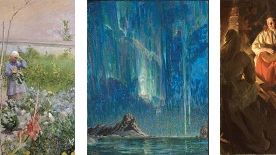
Press release -
The exhibition Light and Darkness opens on 20 June
On 20 June, Nationalmuseum launches its summer exhibition on light and darkness in art and life. The show presents examples of how our most renowned artists have used different techniques to mimic light and create depth. The core focus is on Nordic fin de siècle art, with around a hundred works on display from the museum’s own collection.
How did artists paint light and what effects were they looking to achieve? The exhibition includes examples of 1880s plein air images bathed in daylight, such as Carl Larsson’s watercolour In the kitchen garden, while atmospheric 1890s landscapes are represented not least by Karl Nordström and Bruno Liljefors’ depictions of summer twilight over the sea.
Illuminated interiors are a recurring motif. The students at the art academies pored over the chiaroscuro paintings of the old masters – dark scenes lit by a single candle or hidden light source. Anders Zorn’s cottage interiors in firelight are a variation on this old theme. Another topic is optical and atmospheric phenomena, epitomised by Anna Boberg’s magnificent and rarely shown paintings of the Northern Lights and the Midnight Sun.
The exhibition also examines the importance and history of the various lighting techniques. The oil lamp revolutionised domestic lighting and often appears in art. Gas lighting and later electricity created new lightscapes, both indoors and around town. The exhibition contains a number of objects from the museum’s collection of applied art and design, from candlesticks and oil lamps to electric chandeliers and desk lamps – from Empire style to Art Nouveau and the fashions of our own time. The technical function is the starting point for the designer, but candlesticks and lamps have always also shed light on the ideals of the age.
A total of over 110 paintings, photographs, drawings and works of applied art are on show from the museum’s collection.Among the artists on display are names such as Anders Zorn, Carl Larsson, Bertha Wegmann, Marcus Larson, Bruno Liljefors, Anna Boberg, Karl Nordström, Hanna Pauli, Eugène Jansson, Jeanna Bauck and Alice Nordin. The exhibition will be accompanied by a short catalogue providing texts and information about the works.
The exhibition will run from 20 June 2012 to 3 February 2013.
Further information
Martin Olin, exhibition curator, martin.olin@nationalmuseum.se
Hanna Tottmar, press officer, hanna.tottmar@nationalmuseum.se, +46 8 5195 4390, +46 767 23 46 32
Press images
Press images with texts from the catalogue are available from www.nationalmuseum.se/pressroom.
Press viewing
Journalists writing about the exhibition can book a viewing by contacting the press officer.
Captions
Carl Larsson, In the Kitchen Garden, 1883; Anna Boberg, Northern Lights; Anders Zorn, A Musical Family, 1905.
Categories

